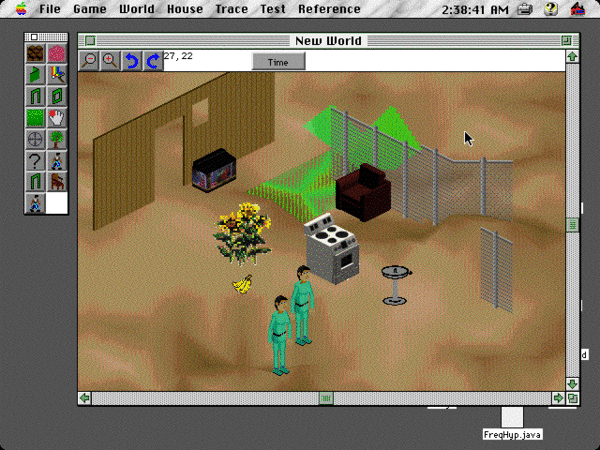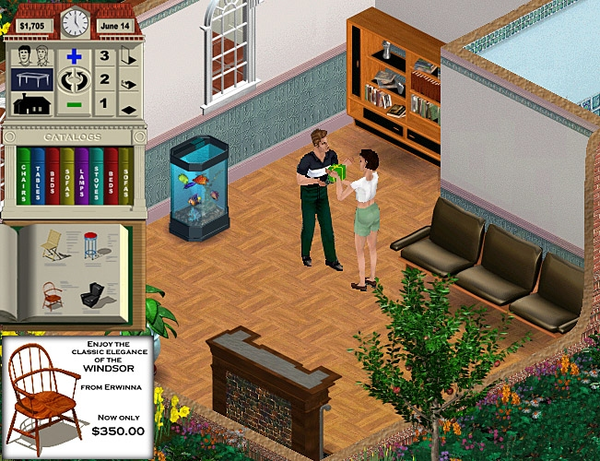Prerelease:The Sims (Windows)/1997

This is a sub-page of Prerelease:The Sims (Windows).
"[...] And so at some point I couldn't get enough resources on The Sims and we wanted to staff it as a project and I said 'well just give me the core tech team.' At that point they said 'sure ... we're not using their stuff anyway.' And so I actually moved Jamie [Doornbos] to that new office and turned the core tech team into the core Sims team. That's how I got the team started. They were still working in a separate office and nobody really saw them. I would drive down there and interact with them several times a week."
- Will Wright[2]
Early 1997
Jefferson

From the moment that Maxis' Core Technology Group showed faith in Project X's character and chances of success, the game is ported to Windows for the first time, and receives a new name: The "Jefferson" project: The project's name is a fun nod to former US President and Constitution co-writer Thomas "Jefferson", of life, liberty, and the pursuit of happiness fame, in a way mirroring the own philosophy of The Sims[4].
Here we see the formation of what would become the game's core team. It includes the original SimCity artists Jenny Martin[footnote 1] and Susan Green, who began work on what would become the very first Sims to be created for the game.[3] At this point we can already see characters with distinct features, although the concept of full customizable heads and bodies was still distant.
In this phase, gameplay was biased towards closed ended scenarios for demo purposes -- this leads to weird cases where there were more scenario savefiles than characters, so duplicates of the same Sims could be spotted multiple times even on the same house.
GUI
| 1996 | 1997 (Mock-up) |
|---|---|
 |
 |
The first known development build of The Sims for Windows introduced a significantly revamped user interface. Gone were the SimCity 2000-inspired roots and MS Paint-style item selection -- such elements were scrapped in favor of a much more original design that seamlessly integrated with the game's upgraded graphics and pre-rendered 3D aesthetic. This new interface featured three core modes: People, Furniture, and Architecture, organizing purchasable items into easily navigable categories. A classic analog clock, placed at the part of the UI that deliberately resembles a house roof, occupied the uppermost corner of the control panel, also providing players with readily accessible information about the current household's funds and, fascinatingly, day of the month.
Characters
Interestingly, this development phase marks the creation and implementation of the first Sims: Edith, Archie, Samantha and Darren.
| Character | Joyful | Neutral | Mad | Body |
|---|---|---|---|---|
| Edith | 
|
✗ | ✗ | ✗ |
| Archie | 
|
✗ | 
|

|
| Samantha | 
|
✗ | ✗ | ✗ |
| Darren | ✗ | 
|

|
✗ |
Gallery
Original storyboard, likely belonging to or near the "Jefferson" period. One of the first pieces of concept art to display the game's isometric look, a decision made by Eric Bowman and his graphics team[4].
The character, Edith, won the hearts of Maxis, to the point where they renamed the Editing Suite after her.
Game Scenarios
Tutorial Home 1: Motives
• You have to work quickly to keep Edith from fainting (and dying) from hunger, and from wetting her pants. First eat, then pee (flush and wash hands!), take a shower and put her to bed.
• The spinning clock in the upper-left indicates Ultra Speed while Edith is asleep.
• There are some itches which only The King can scratch.Tutorial Home 2: Objects
In this tutorial home, we find Archie, his brother Archie, and his other brother Archie. They have almost everything they need to be happy. You have to figure out which objects you need to buy for them so that they can survive indefinitely. You get to enjoy watching Archie sim with himself. Archie operates perfectly well in auto-pilot: he'll attend to his every need, providing that suitable objects are available in his house to satisfy his motives. Some object interactions can satisfy him, but he isn't "drawn" to them [they don't happen to advertise the satisfactions that they can provide], so you may need to personally direct his behavior to entertain himself. Or you can purchase an object which he interacts with on his own to the same end (the Radio). The point of this tutorial is to learn about household objects. Partly, you learn to place new objects into the house. But there is a deeper lesson about objects: they can fail if not maintained. Just try forgetting to flush the toilet for a while.
• It's hard to keep track of which Archie is active. Remember to look for the "flashing brightness" of the "active" Archie.
• Add a TV or Radio to entertain the boys.
• You might want to buy the Archies a second bed, if you get the chance.Tutorial Home 3: Economics
The story... Archie and Darren are living an empty and shallow life of boredom because they have no TV. The only way for them to afford one is for Archie to go do an honest day's work. Get Archie to his carpool on time (and in a good mood) and maybe, just maybe, their lives will be worth living.
• The carpool (played by a honking blue box in the Driveway) appears around 8:00am (Game Standard Time) and waits for about 20 (game) minutes before it gives up and drives off without Archie.
• Archie's happiness affects how much he earns at the job each day. See what other factors affect his salary, promotion, or termination.
• The TV is only the most obvious way to entertain the fellows.
• Just try buying that TV with your first $500, and see if you can get some moolah in the house before Darren dies of starvation. Once he's dead, it's a lot easier for Archie to make ends meet.Tutorial Home 4: Architecture
Archie stands in the driveway to his new home. Unfortunately, he forgot to inspect it before he bought it. It's sort of a fixer-upper. Well, more than sort of. You must now be "Mr. Handyman" before Archie freezes to death or starves. You also have to furnish the house, so you might take the opportunity to do a little expansion remodelling. Once you get ol' Arch squared away, play around with the architecture and landscaping tools for a while. You might want to see if you can mock up your own house and lot.
• For best results (no tree crashes), Pause the game when working on architecture.
• Notice there's no front door, so Archie can't get inside to eat, etc.
• A few more rooms would be nice, but the ground needs to be levelized.
• The hand tool moves trees (pending a chainsaw object)
• Small little houses are not nearly as much fun as monstrously huge mansionsTutorial Home 5: Social Skills
This is a good one. Living in this home are Edith and her sister Edith, the Bernoulli family. Outside the front door of the house is a "visitor generator" which periodically conjures up a visitor who knocks on the front door. The goal of the scenario is to accumulate as many visitors as you can. The visitors, if unsatisfied, will leave the house and disappear back inside the visitor generator (if they can't get satisfaction in your house they won't stick around).
• Remember you are dealing with the shiftless Edith. You have to remember to make her eat, go to the bathroom, go to bed, etc. The visitors have minds of their own.
• You have to manually direct an Edith to openthe front door when visitors arrive.
• You can direct Edith to escort the visitors by clicking on the visitor and selecting "Follow Host." You "release" the visitors by clicking on their "Stop Following" interaction item.
• When the visitors chase down Edith and appear to be praying, they are actually pleading with Edith to talk to them. You can't see it, but they have a very starved "Social" motive, which is why they came up to the front door in the first place
• You'll need to operate both Ediths in parallel to keep up. You have to feed the guests, talk to them, and escort them to the bathroom (oh, yeah, you have to read their minds to figure out what they're agitated about). You also have to keep the Ediths fed and alive (and Happy, or she'll will bum out the visitors). And keep answering that front door!
• In one test run, both Ediths went to bed and the guests kind of ran amok in interesting ways. If you see that, try to remember how you got there and report back to us so we can reproduce it.
• In a later version, Edith will be able to get two visitors chatting amongst themselves, so they stop following her around.
• The visitor looks like the offspring of Darren and Archie from Tutorial Home 4.Tutorial Home 6: Grand Play
A big fancy hard-to-manage house which needs remodeling, receives visitors, is low on funds, and is missing key objects.
• We lied. There is no Tutorial 6 set up. Feel free to horse around in our test home, labelled "LOVELY HOME, Prefurnished." You'll need to manually spawn some people from the tool bar.
• Advanced users: spawn a Samantha and see if you can get her to take a shower for you. Enjoy our clever transparency tricks.
• Be very careful of the Big Brother object. Its low price may deceive you. It can be very benevolent, but it's a very dangerous object. Beware!Overall Info
- This phase of development started a tend that would culminate in the final game's tutorials, preplanned scenarios that taught players the ropes of the game. Because God Sims, let alone domestic God Sims, were relatively new, the tutorials would prove useful to the final game's player base.
- Jefferson presents the earliest record of concepts for Needs as we know today. They're notoriously segmented into 2 types — physical and mental — and mention Alertness and Stress, which didn't make their way to the game's retail build if not as remnants in code and graphics, likely because they redundantly antagonize the Energy and Fun motives, and... well, makes the whole experience unnecessarily stressing.[6]
- Reading the earliest Jefferson drafts, it's easy to see that the game planned to have more sitcom influences then what appears in the final game. This included laugh tracks to help emphasize ingame events. This became stingers and hooks to signify ingame events in the released game.
- The game had a greater emphasis on an ingame calendar that mirrored the real world's. This calendar still exists in the final game, and it even keeps track, but it's hidden from the player at all times.
- Guitars (acoustic or electric) were planned at this point, but were bumped up to the first expansion pack, Livin' Large due to looming deadlines.
- Sims required players to open doors for them[7], rather than something that the Sims did automatically. Remnants of this are left in unused animations, but are never invoked in the final game.
- Jefferson had an interaction where Sims could show visitors around their house. In the final game, visitors innately know the layout of a house.
Late 1997
| To do: Add in the bathroom needs story from the Jake Simpson post. |
Acquisition by EA
Dark Ages for Maxis
Despite the successful launch of SimCity 2000 in 1994, Maxis followed the advice of its private investors and took the company public in 1995. Issues pertaining to a public posting, including the need for regular quarterly profits, put increasing pressure on Maxis to turn out products to make a profit.
This led to the development and release of Full Tilt! Pinball, SimCity Jr. and Streets of SimCity in short order, putting Project X on a distant backburner, hindered by its black sheep status within the company.
Cha(lle)nge Everything
"Will Wright and Jim Mackraz deserve a lot of credit for keeping the team together and focused on shipping a successful product, through the tumultuous times of EA buying Maxis, questioning the value of the project and trying to change its essential design, and moving the team all around. Early on, Luc Barthelet from EA saw the light and championed the project with the executive team as well as the fans. I recall that one of our most difficult accomplishments was convincing EA not to cancel the project, because some of the EA old guard didn’t trust nor respect Will’s vision, didn’t “get” the idea of Dollhouse, didn’t think it would sell, wanted to inject it full of their old tried and trusted formula, and wanted to gut out the most interesting parts of the game (like the architecture tools). I think it’s a lucky fluke that The Sims ever shipped, and I hope EA has learned enough from their experience to trust the projects that Will is directly involved in, listen to what he’s been saying eloquently and consistently for years, and let something like The Sims happen again."
Around this time, it became apparent that, in order to salvage their sinking reputation- and profits- they would need to be bought out by a larger company. There were talks both with Infogrames and Activision, though, ultimately, Electronic Arts Electronic Arts bought Maxis, for a sum of $125 million dollars, on July 28, 1997[8].
Electronic Arts was not happy with how Maxis was structured, but in the end, was won over by the success of SimCity 3000. Thus, the development team was allowed to pursue a newly renamed The Sims, fully to Will Wright's vision.
Footnotes
- ↑ Do not confuse with Jerry Martin, the man behind many of the audio tracks from the Sim series' games from the late nineties to 2004.
References
- ↑ [The Soul of The Sims, by Will Wright]
- ↑ "Will Wright Speaks Simlish" 2/8 - GameSpy, Feb. 27, 2005
- ↑ 3.0 3.1 3.2 3.3 INTERVIEW WITH DON HOPKINS - THE SECOND LIFE HERALD, February 12, 2004
- ↑ 4.0 4.1 Using Technology and Innovation toSimulate Daily Life, by Michael Macedonia
- ↑ SimAntics | SimsTek Wiki - Fandom]
- ↑ "JeffersonCharacterMotives", Design Document
- ↑ "JeffersonDemoTutorial", Design Document
- ↑ Maxis Now Under EA's Wing - Gamespot News





